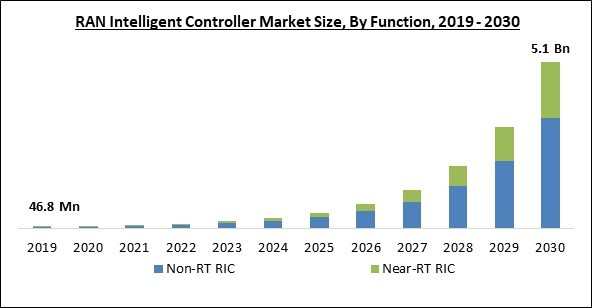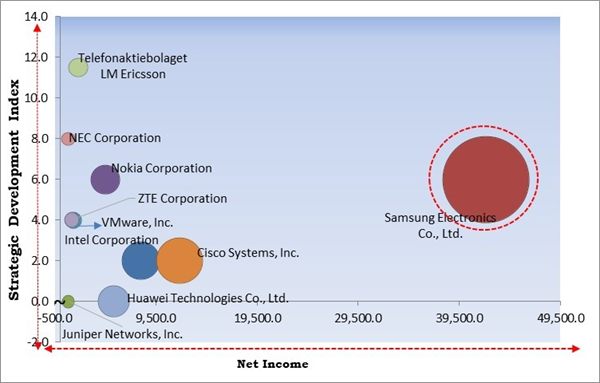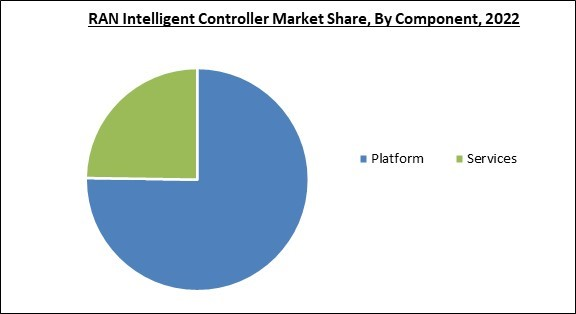The Global RAN Intelligent Controller Market size is expected to reach $5.1 billion by 2030, rising at a market growth of 58.2% CAGR during the forecast period.
The upcoming 5G era can be described as limitless connectivity for everyone and intelligent automation that will improve people's lives and change industrial processes. Therefore, the 5G segment will capture 1/4thshare in the market by 2030. More people rely on mobile connectivity in today's environment, and 5G is predicted to accelerate connectivity to supply mobile data services. To provide a limitless, high-speed, dependable, and secure internet experience and enable a wide range of use cases for society, 5G networks will integrate with 4G and alternative network technologies. The ability to work across industries, including finance, transportation, retail, and health, has allowed telecoms to go beyond connectivity and offer new, comprehensive services.
The major strategies followed by the market participants are Partnerships as the key developmental strategy to keep pace with the changing demands of end users. For instance, In July, 2023, Intel teamed up with Ericsson to enable communications service providers to increase network capacity and energy efficiency by optimizing 4th Gen Intel Xeon Scalable processors with Intel vRAN Boost for Ericsson’s Cloud RAN (radio access network) solutions. Additionally, In March, 2023, Nokia Corporation collaborated with AT&T to drive innovation further to streamline the process and ensure a premium experience for end users.
The market research report covers the analysis of key stake holders of the market. Key companies profiled in the report include Nokia Corporation, VMware, Inc., Intel Corporation, Samsung Electronics Co., Ltd. (Samsung Group), Huawei Technologies Co., Ltd. (Huawei Investment & Holding Co., Ltd.), Cisco Systems, Inc., ZTE Corporation, NEC Corporation, Juniper Networks, Inc. and Telefonaktiebolaget LM Ericsson.
The upcoming 5G era can be described as limitless connectivity for everyone and intelligent automation that will improve people's lives and change industrial processes. Therefore, the 5G segment will capture 1/4thshare in the market by 2030. More people rely on mobile connectivity in today's environment, and 5G is predicted to accelerate connectivity to supply mobile data services. To provide a limitless, high-speed, dependable, and secure internet experience and enable a wide range of use cases for society, 5G networks will integrate with 4G and alternative network technologies. The ability to work across industries, including finance, transportation, retail, and health, has allowed telecoms to go beyond connectivity and offer new, comprehensive services.
The major strategies followed by the market participants are Partnerships as the key developmental strategy to keep pace with the changing demands of end users. For instance, In July, 2023, Intel teamed up with Ericsson to enable communications service providers to increase network capacity and energy efficiency by optimizing 4th Gen Intel Xeon Scalable processors with Intel vRAN Boost for Ericsson’s Cloud RAN (radio access network) solutions. Additionally, In March, 2023, Nokia Corporation collaborated with AT&T to drive innovation further to streamline the process and ensure a premium experience for end users.
The Cardinal Matrix - Market Competition Analysis
Based on the analysis presented in the The Cardinal Matrix; Samsung Electronics Co., Ltd. is the forerunner in the Market. In October, 2022, Samsung Electronics Co., Ltd. partnered with Vodafone Group plc, to fasten the adaptability and Performance of 5G Open Radio Access. Networks (RAN) across Europe. Companies such as Cisco Systems, Inc., Intel Corporation, Nokia Corporation are some of the key innovators in the Market.Market Growth Factors
Increasing need for network enhancement
Network optimization is a key driver behind the RAN intelligent controller (RIC), enabling network operators to enhance the radio access network's (RAN) performance and efficiency. Due to the increased complexity of 5G networks and the need for efficient resource allocation, network optimization is crucial for ensuring optimal network performance and user experience. The RIC is a centralized intelligence hub that uses cutting-edge algorithms, artificial intelligence (AI), and real-time network insights to enhance various RAN components. The user experience, network capacity, and latency are all enhanced by using this optimization technique. The market will expand in the coming years due to the rising demand for network enhancement.Open interfaces and ecosystem collaboration
Open interfaces and ecosystem cooperation, which encourage interoperability, vendor neutrality, and innovation in the telecommunications industry, are the driving forces behind the RAN intelligent controller (RIC). Due to the RIC's emphasis on open interfaces and cooperation, network operators incorporate solutions from several providers, reduce vendor lock-in, and foster a competitive market. Open interfaces enable interoperability between different components and providers within the RAN architecture. The RIC's open APIs and established interfaces enable effortless network integration of base stations, antennas, and network management systems. By providing innovators with a space to collaborate and launch novel goods and services into the market, the RIC acts as a catalyst for industrial innovation, thereby propelling the growth of the market.Market Restraining Factors
Security issues with 5G
The 5G wireless telecommunications infrastructure is based on older technologies, such as 4G LTE networks. The security of 5G networks will be at risk from any flaws that exist in those networks. To adopt 5G technology, more elements are needed, increasing the number of access points and network edges. Beamforming, tiny cells, cellular devices, and cellular towers are commonly used in 5G technology infrastructure. It expands the area that can be attacked online. A lot of these components also don't have any physical security features. These sections focus on particular use scenarios especially in sectors like automotive, healthcare, and essential infrastructure. As a result, the market has a significant security-related problem.Function Outlook
On the basis of function, the market is segmented into non-real-time-RAN intelligent controller (non-RT RIC) and near-real-time-RAN intelligent controller (Near-RT RIC). The near-real-time-RAN intelligent controller (Near-RT RIC) segment recorded a remarkable revenue share in the market in 2022. A telco edge or regional cloud is where the Near Real-Time RIC is located, and it often allows network optimization procedures that take ten milliseconds to 1 second to complete. The near RT RIC manages the cloud edge RAN infrastructure. Cloud-native microservice-based applications known as xApps are hosted by the near-RT RIC.Component Outlook
Based on component, the market is fragmented into platform and services. In 2022, the platform segment held the highest revenue share in the market. The growth of the segment is due to the provision of a centralized command center that organizes and manages various RAN tasks and resources, including base stations, antennas, and other network elements. To enhance user experience and network performance, the RIC platform makes intelligent decisions based on real-time data analysis and machine learning algorithms.Application Outlook
On the basis of application, the market is categorised into rApps and xApps. The xAPPs segment recorded a remarkable share in the market in 2022. xApps are programs created for the Near-RT RIC and must be executed in less than a second. Security, mobile, and radio resource management are among xApps' features or activities. As the algorithm would need to execute in tens or hundreds of milliseconds to guarantee user network access, optimizing network handovers is an example of an xApp. Additionally, xApps can provide QoS features like traffic control or congestion.Technology Outlook
By technology, the market is classified into 4G and 5G. In 2022, the 4G segment witnessed the largest revenue share in the market. The fourth generation of wireless cellular technologies, or 4G, has gained a lot of global adoption. Additionally, it can grow in emerging nations like Sub-Saharan Africa, and operators aim to convert 2G and 3G users to 4G. To provide 4G clients with enhanced services, mobile network operators will utilize intelligent technology like RAN intelligent controllersRegional Outlook
Region wise, the market is analysed across North America, Europe, Asia Pacific, and LAMEA. In 2022, North America region generated the highest revenue share in the market. Internet and smartphone use are highly prevalent in North America, which has a robust technology infrastructure. Additionally, regional government initiatives will probably support the development of the 5G and RAN intelligent controller markets. Aside from that, because of the emergence of 5G technology, the growth of mobile networks, the deployment of Internet of Things (IoT) gadgets, and the requirement for effective network management.The market research report covers the analysis of key stake holders of the market. Key companies profiled in the report include Nokia Corporation, VMware, Inc., Intel Corporation, Samsung Electronics Co., Ltd. (Samsung Group), Huawei Technologies Co., Ltd. (Huawei Investment & Holding Co., Ltd.), Cisco Systems, Inc., ZTE Corporation, NEC Corporation, Juniper Networks, Inc. and Telefonaktiebolaget LM Ericsson.
Strategies Deployed in the Market
Partnerships, Collaborations and Agreements:
- Jul-2023: Intel teamed up with Ericsson, a networking and telecommunications company. Through this collaboration, both companies aimed to enable communications service providers to increase network capacity and energy efficiency by optimizing 4th Gen Intel Xeon Scalable processors with Intel vRAN Boost for Ericsson’s Cloud RAN (radio access network) solutions.
- Mar-2023: Nokia Corporation collaborated with AT&T T and accomplished a successful trial of an Open RAN compliant near real-time RAN Intelligent Controller (RIC) with a native E2 interface. With this collaboration, the company is looking to drive innovation further to streamline the process and ensure a premium experience for end users.
- Mar-2023: ZTE Corporation formed a partnership with Telekom Malaysia Berhad, a Malaysian telecommunications company. The partnership aimed to develop a hybrid cloud 5G core designed for future technologies to offer a converged, open, reliable, trusted, and efficient 5G core network.
- Feb-2023: Nokia expanded its partnership with Hewlett Packard Enterprise, intelligent solutions and cloud-based services provider. With this partnership, the company aimed to offer various advantages to businesses with the help of Cloud RAN by combining its technology and expertise.
- Dec-2022: Ericsson AB came into collaboration with Singtel Optus Pty Limited, an Australian telecommunications company headquartered in Macquarie Park, New South Wales, Australia. Under this collaboration, the organizations would deploy Australia’s latest energy-efficient radio access network (RAN) site at Optus’ Moorebank site in Sydney, New South Wales. Moreover, this is a crucial step for Ericsson AB toward its mission to be Net Zero across their value chain by 2040. This would further reduce emissions by 50% in their portfolio in use and supply chain by 2030.
- Nov-2022: VMware entered into a partnership with Viavi Solutions Inc., a network test, monitoring, and assurance solutions provider. With this partnership, both companies aimed to help industries boost the adoption of open RAN and standardized frameworks and metrics for RAN Intelligent Controller (RIC) testing.
- Oct-2022: Samsung Electronics Co., Ltd. partnered with Vodafone Group plc, a British multinational telecommunications company, and Marvell, an American company, headquartered in Santa Clara, California, which develops and produces semiconductors and related technology. Under this partnership, Samsung Electronics Co., Ltd. would be able to fasten the adaptability and Performance of 5G Open Radio Access. Networks (RAN) across Europe. Moreover, Samsung Electronics Co., Ltd. considers that this collaboration with Vodafone and Marvell would enable the Open RAN environment, through which Samsung would be able to continue to guide the growth of the ecosystem.
- Oct-2022: Ericsson AB partnered with Reliance Jio Infocomm Ltd., an Indian telecommunications company and a subsidiary of Jio Platforms, headquartered in Navi Mumbai, Maharashtra, India. Through this partnership, both organizations would roll out 5G Standalone in India. Moreover, Ericsson AB 5G Standalone connectivity would be a major booster in coping with the digital transformation objectives across enterprises, industry, and society.
- Aug-2022: NEC Corporation partnered with Fortinet, a broad, integrated, and automated cybersecurity solutions provider. By combining Fortinet's best-in-class security solutions, including FortiGate with the NEC's professional services, both companies aimed to develop secure 5G networks for communication service providers (CSPs).
- May-2022: Samsung Electronics Co., Ltd., came into collaboration with DISH Network Corporation, an American television provider and the owner of the direct-broadcast satellite provider Dish. Through this collaboration, Samsung Electronics Co., Ltd. would be able to deploy 5G Open Radio Access Network solutions across the DISH Wireless’ SMART 5G network. Moreover, Samsung Networks Business would supply DISH Wireless with its RAN and 5G solutions and this would further enable more customers to experience the whole value of commercial 5G Open RAN.
- Feb-2022: Nokia Corporation came into partnership with Kyndryl Inc., the world’s largest IT infrastructure services provider. Through this partnership, the organizations have declared the global network and edge computing partnership focused to enable enterprise customers to fasten their digital transformations with industrial-grade dependable and protected LTE and 5G private wireless networking. Furthermore, Nokia Corporation would be able to transform more organizations' operations which would lead to fastening their digitalization path and reaping the benefits of Industry 4.0.
- Nov-2021: Samsung Electronics Co., Ltd. collaborated with Orange S.A., a French multinational telecommunications corporation. Under this collaboration, Samsung Electronics Co., Ltd. would become the first vendors to participate in the opening of Orange’s Open RAN Integration Center in Paris, France. Moreover, Samsung Electronics Co., Ltd. would be seeking ahead, to take networks to fresh heights in the European market, allowing operators to deliver more immersive mobile services to their users.
- Nov-2021: Cisco came into an agreement with DISH Wireless, a television provider based in America. Under this agreement, both companies would boost 5G services across the United States. Additionally, the agreement would allow businesses to gain on DISH’s 5G network and application infrastructure to aid the latest hybrid work models.
- Nov-2021: ZTE Corporation collaborated with Riedel Communications, a German manufacturer of communications equipment and an equipment distributor. Through this collaboration, ZTE Corporation would be able to place a custom-made Private 5G as a Service on a campus network and together explore the potential of 5G networks in the digital economy era. Moreover, placing a combination of 5G applications allows the shift from traditional manufacturing to intelligent manufacturing with increased quality, reduced costs, and efficiency.
- Oct-2021: VMware, Inc., came into partnership with Polte Corporation, the innovator of Cloud Location over Cellular (C-LoC) technology. By leveraging Polte as a xApp on the company's RAN Intelligent Controller (RIC) platform, both companies aimed to meet the growing demand for enterprise security while delivering accuracy with private networks.
- Jun-2021: NEC Corporation entered into a partnership with Microelectronics Technologies Inc. (MTI), a network RF solutions provider. With this partnership, the company aimed to enhance its Open RAN product offering to serve 4G and 5G markets globally.
Mergers & Acquisition:
- Jul-2022: NEC Corporation took over Aspire Technology, an Irish company that specializes in the integration of open networks. Through this acquisition, NEC Corporation would strengthen its place in the growing Open Radio Access Network (OpenRAN) sector. Moreover, NEC Corporation would organize more satisfactorily as compared to any other supplier to integrate disaggregated network components into a well-tuned ecosystem.
Geographical Expansions:
- Mar-2021: Ericsson AB expanded its geographical footprints by establishing the Ericsson Open Lab. The new lab is a fresh space to unite and innovate with ecosystem partners and leading Ericsson Cloud RAN customers to operate virtualized 5G Radio Access Networks (RAN) technologies. Additionally, Ericsson Open Lab is available virtually to customers globally and it is co-located with the company’s Cloud RAN expertise at Ericsson’s R&D site in Ottawa.
Scope of the Study
By Function
- Non-RT RIC
- Near-RT RIC
By Component
- Platform
- Services
By Application
- rApps
- xApps
By Technology
- 4G
- 5G
By Geography
- North America
- US
- Canada
- Mexico
- Rest of North America
- Europe
- Germany
- UK
- France
- Russia
- Spain
- Italy
- Rest of Europe
- Asia Pacific
- China
- Japan
- India
- South Korea
- Singapore
- Malaysia
- Rest of Asia Pacific
- LAMEA
- Brazil
- Argentina
- UAE
- Saudi Arabia
- South Africa
- Nigeria
- Rest of LAMEA
Key Market Players
List of Companies Profiled in the Report:
- Nokia Corporation
- VMware, Inc.
- Intel Corporation
- Samsung Electronics Co., Ltd. (Samsung Group)
- Huawei Technologies Co., Ltd. (Huawei Investment & Holding Co., Ltd.)
- Cisco Systems, Inc.
- ZTE Corporation
- NEC Corporation
- Juniper Networks, Inc.
- Telefonaktiebolaget LM Ericsson
Unique Offerings
- Exhaustive coverage
- The highest number of Market tables and figures
- Subscription-based model available
- Guaranteed best price
- Assured post sales research support with 10% customization free
Table of Contents
Chapter 1. Market Scope & Methodology
Chapter 2. Market at a Glance
Chapter 3. Market Overview
Chapter 4. Competition Analysis - Global
Chapter 5. Global RAN Intelligent Controller Market by Function
Chapter 6. Global RAN Intelligent Controller Market by Component
Chapter 7. Global RAN Intelligent Controller Market by Application
Chapter 8. Global RAN Intelligent Controller Market by Technology
Chapter 9. Global RAN Intelligent Controller Market by Region
Chapter 10. Company Profiles
Companies Mentioned
- Nokia Corporation
- VMware, Inc.
- Intel Corporation
- Samsung Electronics Co., Ltd. (Samsung Group)
- Huawei Technologies Co., Ltd. (Huawei Investment & Holding Co., Ltd.)
- Cisco Systems, Inc.
- ZTE Corporation
- NEC Corporation
- Juniper Networks, Inc.
- Telefonaktiebolaget LM Ericsson











